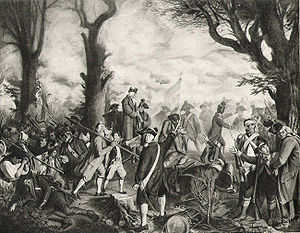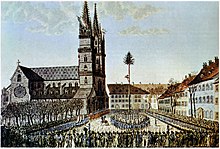French invasion of Switzerland
| French invasion of Switzerland | |||||||
|---|---|---|---|---|---|---|---|
| Part of the French Revolutionary Wars | |||||||
 The Last Days of Old Bern, Friedrich Walthard | |||||||
| |||||||
| Belligerents | |||||||
|
|
| ||||||
| Commanders and leaders | |||||||
|
|
| ||||||
The French invasion of Switzerland (French: Campagne d'Helvétie, German: Franzoseneinfall) occurred from January to May 1798 as part of the French Revolutionary Wars. The independent Old Swiss Confederacy collapsed from the invasion and simultaneous internal revolts called the "Helvetic Revolution". The Swiss Ancien Régime institutions were abolished and replaced by the centralised Helvetic Republic, one of the Sister Republics.
Background[]
Before 1798, the modern region of Vaud belonged to the Canton of Bern, to which it had a dependent status. Moreover, the majority of Francophone Catholic Vaudois felt oppressed by the German-speaking Protestant majority of Bern. Several Vaudois patriots such as Frédéric-César de La Harpe advocated for independence. In 1795, La Harpe called on his compatriots to rise up against the Bernese aristocrats, but his appeal fell to deaf ears, and he had to flee to Revolutionary France, where he resumed his activism.

In late 1797, French general Napoleon Bonaparte, who had just successfully conquered northern Italy and founded the Cisalpine Republic, pressed the French Directory to occupy Switzerland; soon 10,000 troops gathered near the city of Genève.[1] Valtellina, Chiavenna and Bormio, dependencies of the Three Leagues, revolted and with French support seceded from the Confederacy to join the Cisalpine Republic on 10 October 1797. In December, the southern part of the Prince-Bishopric of Basel was occupied and annexed to France.[2] The atmosphere inside Switzerland had changed significantly due to these developments, and many pro-French patriots hoped, and anti-French conservatives feared, that the Revolution would now spread to the rest of the Confederacy, with or without direct French military intervention. France used the dissatisfaction of the rural elites in the dependencies and the Enlightened citizenry in the cantons to stimulate revolutionary excitement.[2]
The first event of what would become known as the "Helvetic Revolution" happened with a patriot uprising in Liestal in the Canton of Basel on 17 January. The rebels demanded legal equality, erected a liberty tree and burnt down three Vogtei castles by 23 January.[3] On 24 January 1798, the urban elite of Vaud proclaimed the Lemanic Republic (French: République lémanique)[4] in Lausanne, which became its seat of government.[5] Next, citizens and subjects in countless Swiss cities, cantons and their dependencies rebelled, and after the example of Vaud, more than 40 other short-lived republics were proclaimed in February, March and April throughout the country.[1]
Invasion[]
At the invitation of French-speaking factions in Vaud, 12,000 French troops under general Ménard invaded Vaud on 28 January. An alleged incident, in which French soldiers were killed by Swiss soldiers, was cited as a pretext.[1] They occupied Vaud without resistance and were cheered on by the population. A second army under general Schauenburg advanced from Mont-Terrible, the former Prince-Bishopric of Basel, towards Bern and demanded its government to put pro-French Revolutionary parties in power. The Bernese refusal to do so was used by the French to justify war. On 3 February, the Légion fidèle or "Loyal Legion" was formed out of French-speaking volunteers from Vaud who wished to stay loyal to Bern and recapture the Lemanic Republic.

There were minor skirmishes on 2–5 March 1798, leading to the swift collapse of the Old Confederacy. On 5 March, the French attained a clear victory in the Battle of Grauholz over the Bernese forces, confirming Vaud's secession. It led to even more dependencies across Switzerland declaring themselves independent republics. However, the Directory desired a single central republican state at France's eastern border, not dozens of small ones, and steered towards (re)establishment of national unity, though this time with equality for all its subdivisions. A new Constitution had already been written in Paris by Peter Ochs and approved by the Directory. Many Swiss rebels detested it, and the National Convention in Basel passed a modified version, which was then adopted by many other entities, but the French government insisted on the original. A proposal by Supreme Commander Guillaume Brune on 16 and 19 March to divide Switzerland into three republics was also overruled; Paris enforced its design.[6]
On 12 April 1798, 121 cantonal deputies proclaimed the Helvetic Republic, "One and Indivisible". The new régime abolished cantonal sovereignty and feudal rights. The occupying forces established a centralised state based on the ideas of the French Revolution. The clashes of April and May represent the last pockets of resistance against the recently established Helvetic Republic. The Nidwalden uprising (Schreckenstage von Nidwalden) in September was more serious, with 435 dead, including 118 women and 25 children. Its repression confirmed the new political situation.
Battles[]

| Date | Battle | Site | Notes |
|---|---|---|---|
| 2 March 1798 | Battle of Lengnau | Lengnau | France vs. Bern |
| 2 March 1798 | Battle of Twann | Twann | France vs. Bern |
| 2 March 1798 | Battles of Grenchen and Bellach | Grenchen, Bellach | France defeats Solothurn |
| 3 March 1798 | Battle of Col de la Croix | Col de la Croix | France vs. Bern |
| 5 March 1798 | Battle of St. Niklaus | Merzligen | France vs. Bern |
| 5 March 1798 | Battle of Fraubrunnen | Fraubrunnen | France defeats Bern |
| 5 March 1798 | Battle of Grauholz | Schönbühl | France defeats Bern |
| 5 March 1798 | Battle of Neuenegg | Neuenegg | Bern defeats France |
| 26 April 1798 | Battle of Hägglingen | Hägglingen | France defeats Zug |
| 30 April 1798 | Battle of Wollerau | Wollerau | France defeats Schwyz |
| 1 May 1798 | Battle of Stucketen-Chäppeli | Beinwil SO | France vs. Solothurn |
| 2 May 1798 | Battle of Schindellegi | Feusisberg | France defeats Schwyz |
| 2/3 May 1798 | Battle of Rothenthurm | Rothenthurm | Schwyz defeats France |
| 17 May 1798 | 1st Battle of Pfyn | Sion | France defeats Valais |
| 7–9 September 1798 | Nidwalden uprising | Nidwalden | France defeats Nidwalden |
Aftermath[]
The invasion strained the recently concluded Treaty of Campo Formio (18 October 1797) that had ended the War of the First Coalition against France. Now, the European monarchies once again feared republican France was expanding its grip on the continent, and had to be opposed and driven back. The French conquest of Switzerland, which had maintained its neutrality ever since the outbreak of the French Revolution, was one of the reasons for the formation of the Second Coalition, and would see an Austro-Russian army conduct the Italian and Swiss expedition in 1799 and 1800.
References[]
- ^ Jump up to: a b c Nappey, Grégoire (2012). Swiss History in a Nutshell. Basel: Bergli Books. p. 43. ISBN 9783905252453. Retrieved 11 May 2016.
- ^ Jump up to: a b Andreas Fankhauser (27 January 2011). "Helvetische Republik. §1.1 - Die politische Umwälzung". Historical Dictionary of Switzerland (in German). Retrieved 26 May 2016.
- ^ Andreas Fankhauser (24 March 2011). "Helvetische Revolution §2. Die Helvetische Revolution vor dem französischen Angriff". Historical Dictionary of Switzerland (in German). Retrieved 26 May 2016.
- ^ The word lémanique referred to the French name of Lake Geneva, Lac Léman. This followed the practice of Revolutionary France to erase the traditional toponymy of the Ancien Régime, and replace it with natural units such as rivers.
- ^ Hug, Lina; Stead, Richard (1890). The Story of Switzerland. United States: Library of Alexandria. p. 210. ISBN 9781465597243. Retrieved 11 May 2016.
- ^ Andreas Fankhauser (24 March 2011). "Helvetische Revolution §3. Die Entwicklung nach dem französischen Einmarsch". Historical Dictionary of Switzerland (in German). Retrieved 26 May 2016.
- Conflicts in 1798
- 1798 in Europe
- Campaigns of the French Revolutionary Wars
- Wars involving Switzerland
- Invasions by France
- 18th century in the Old Swiss Confederacy